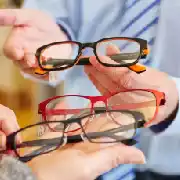What Happens In Keratoconus
The Cornea is the front part of the eye lens, made of collagen fibers, which makes the light fall onto the retina. In a Keratoconus Eye, the layers of the cornea start thinning out, moreso in the central area. This thinning out causes the cornea to become weak and change its shape from a dome-like structure to a cone-like structure which leads to induction of high Astigmatism.
This thinning also causes the cornea of the Keratoconus Eye to become irregular in shape which in turn prevents all the light rays entering our eyes to focus accurately onto the Retina. These two factors cause a drop in the patient's vision.
At late stages of the disease, the cornea becomes extremely thin and is unable to withstand the pressure from within the eyes. This leads to small tears in the Cornea and accumulation of fluid in its layers leading to a condition called 'Acute Hydrops'. This causes a sudden loss of vision accompanied by pain, watering and redness. Keratoconus Treatment in early stages and advanced stages of this disease vary significantly.
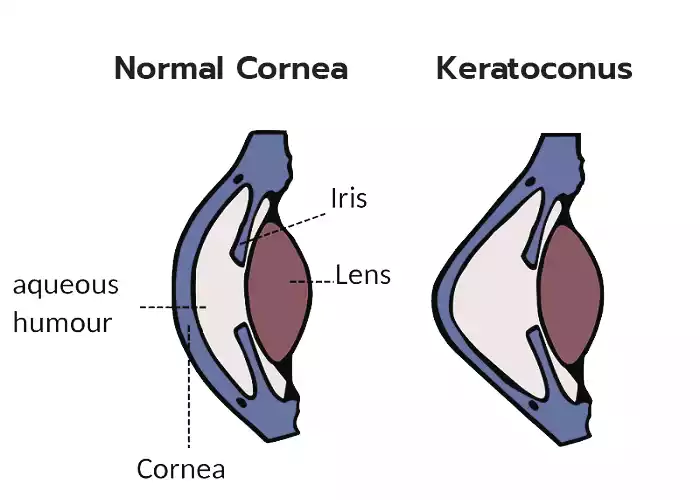
Symptoms
Keratoconus usually affects teenagers and young adults
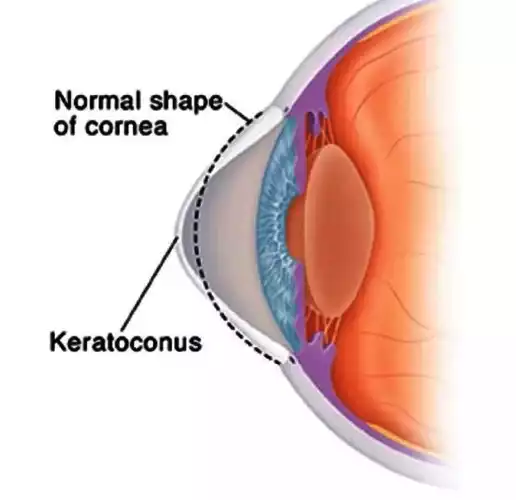
Causes Of Keratoconus
Although there is no proven cause for Keratoconus, numerous risk factors have been identified which can trigger the progress of the condition.
- Vigorous Eye Rubbing, especially in childhood [due to allergic causes] is one of the major identified risk factors of Keratoconus.
Some of the other risk factors include family history, age, race and certain genetic conditions such as down syndrome.
Keratoconus Treatment
Keratoconus Treatment cannot reverse the thinning of the Cornea. However, the basis of Keratoconus Eye Treatment is to prevent the further progression of the disease so as to reduce the extent of vision loss caused by the disease. Early Keratoconus Treatment is always advocated to prevent adverse complications. Modern Keratoconus Treatment modalities are safe and effective with a proven track record.
Riboflavin Assisted Corneal Collagen Cross-Linking [C3R]
Corneal Cross Linking is a type of Cornea Surgery and is the most commonly recommended type of Keratoconus Treatment to strengthen the Corneal Eye Layers. This Cross-linking Treatment involves the use of Riboflavin drops which soak into the Cornea. UV radiation is then applied to stimulate the corneal layers to form strong chemical bonds which improve the strength of these layers.
The C3R Keratoconus Surgery thus prevents the cornea from weakening and bulging further. C3R procedure if done at an early stage can safely help in ensuring that vision loss does not progress. Keratoconus Eye Surgery cannot be done at later stages of the disease when the cornea becomes extremely thin or when the integrity of the cornea has been compromised [such as due to scarring or acute hydrops].
In cases of extremely thin Corneas, Keratoconus Treatment using Corneal Cross Linking can still be done with some modifications such as Hypotonic C3R, contact lens assisted C3R, etc. In case of scarred corneas or compromised corneas, C3R Surgery would not be effective and the Cornea Surgery of choice would be to perform a Corneal Transplant.
All patients require Visual Rehabilitation after Cross Linking Surgery to complete the Keratoconus Treatment as it DOES NOT REVERSE the Corneal Astigmatism. Visual Rehabilitation is usually in the form of spectacles [in very early stages of the disease] or in the form of specialized contact lenses such as rigid gas permeable lenses[RGP's], Rose-K contact lenses, Scleral or Mini-Scleral Lenses.
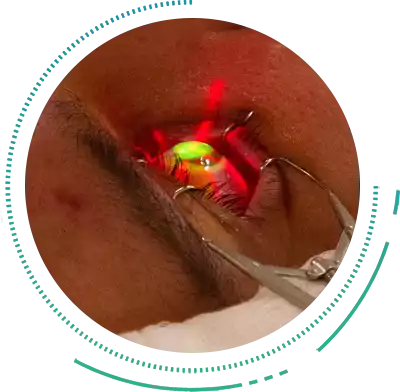
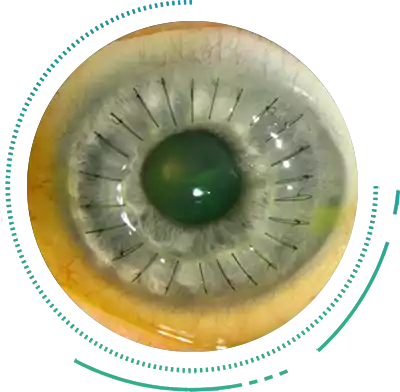
Keratoplasty: Lamellar(DALK) or Penetrating [Corneal Transplantation]
Keratoplasty is a Cornea Surgery where a donor healthy cornea is grafted in the place of a diseased host cornea. Keratoplasty for a Keratoconus Eye is only reserved for advanced cases where C3R surgery is contraindicated or in cases of corneal scarring or corneal compromise. The diseased cornea of the patient is removed out and the donor cornea is grafted in its place. Depending on the extent of the Keratoconus and the status of the Cornea, Corneal Transplantation for Keratoconus can be:
Penetrating Keratoplasty:
In this Keratoconus Treatment, all the layers of the cornea layer (full thickness) are replaced with the donor’s cornea. Penetrating Keratoplasty Cornea Surgery is usually recommended when the corneal layers are extensively affected, including its water tightness and transparency.
Lamellar Keratoplasty:
[Partial thickness Corneal Transplantation Cornea Surgery] For a Keratoconus Eye with extreme corneal thinning but whose water-tightness is still present, a partial thickness grafting of only the front layers of the cornea is performed as a method of Corneal Cross Linking Keratoconus Treatment. Lamellar Keratoplasty has the advantage of having a lower graft rejection and failure rate as compared to the Penetrating Keratoplasty Procedure of Keratoconus Treatment.
Frequently Asked Questions
What is Keratoconus?
Keratoconus, is a condition where the cornea becomes very steep, thin and irregular and bulge outward like a cone. This condition prevents the irregular cornea from properly focusing the light onto the retina, thereby reducing the vision
What are the Symptoms of Keratoconus??
Symptoms of Keratoconus include
- Frequent change of Glasses
- Headaches
- Vision not correcting completely even with glasses
What is the usual age of onset of Keratoconus? How fast does it progress?
It may occur in people from teenages to even 40 years or more. IEven though its diagnosed earlier, it may gradually grow and stabilize.
Does Keratoconus affect both eyes?
Yes, it does affect both the eyes in the majority of the cases.
What are the treatment options available?
- Riboflavin assisted Corneal Collagen Cross-Linking [C3R]
- Keratoplasty: Lamellar [DALK] or Penetrating
Can Keratoconus Go Away On Its Own?
The answer is No. Keratocomus doesn’t fade on its own. The shape of your cornea can't change, without medications, contact lenses or even surgery.
Can Keratoconus Cause Dry Eye?
Yes, there is a high chance because your eyes lose the ability to spread tears over your uneven Cornea.
Does Keratoconus Cause Eye Pain?
In some cases your eyes will ache due to the Keratoconus. Eye Irritation is common accompanied with some mere pain.
What Do I Do If I Think I Have Keratoconus?
Consult our leading Eye Doctors immediately and get your eyes checked at Sri Eye Care, a Super Speciality Eye Care Hospital located in Bengaluru. And Based on the consultation and prescription choose your lenses or even Keratoconus Surgery in severe cases.
What about relatives of people with Keratoconus?
In those cases, one copy of the altered gene in each cell may cause the disorder. Usually, it is not inherited. But there are rare cases which can be seen too.
Can I undergo LASIK correction for Keratoconus?
Absolutely not! Keratoconus is the number one contraindication for LASIK procedure as LASIK reshapes the cornea by thinning out the central cornea. Since the cornea is already weak, irregular and thin in Keratoconus, further thinning out the cornea would have disastrous effects.

